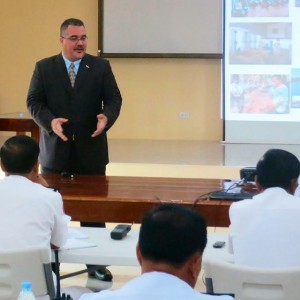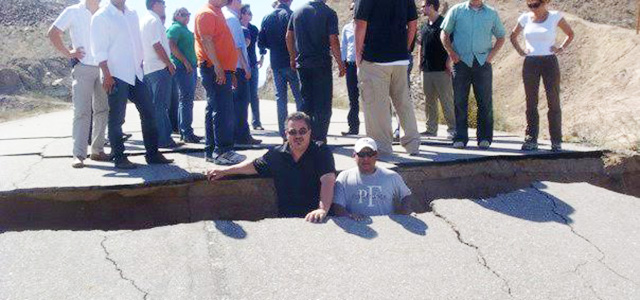
Dr. McIllwain teaching whole-of-government approaches to humanitarian assistance and disaster response to officers in the Cambodian Navy.
One-Unit Weekend courses allow SDSU undergraduate students to earn extra units for graduation while also learning about the latest developments on important current issues. Offered through the College of Extended Studies, each course meets only twice: typically a Friday/Saturday combination for a total of 15 classroom hours.
Course topics are so intriguing that community members often take advantage of the fact that they’re open to the public. Topics have included international diplomacy, youth gangs, popular culture and criminal justice, substance abuse policies and practices, and restorative justice. Instructor Jeffrey McIllwain teaches Introduction to Emergency Management.
What are some of the accomplishments you’d like to highlight from your multi-faceted career?
I am the co-founder and former co-director of the graduate program in Homeland Security, the former director of the International Security & Conflict Resolution program, and coordinator of the graduate program in Criminal Justice and Criminology at SDSU. I currently serve as a faculty fellow in SDSU’s Weber Honors College. I also serve as a fellow and adjunct faculty member in the Operational Studies department at Joint Special Operations University, the war college for U.S. Special Operations Command (USSOCOM), and a subject-matter expert on the Islamic State for I Marine Expeditionary Force.
The American Society of Criminology nominated my most recent book, Deconstructing Organized Crime (McFarland, 2012; co-authored with Joseph Albini), for its 2014 Outstanding Book Award. I really enjoy leading my annual and bi-annual CES study abroad courses. We study D-Day and WWII in France, WWI in France and Belgium, life under the Nazis and Communists in Poland, and British and American intelligence and security in Cambridge, England (the latter two will be taught during the summer of 2016).
Were you interested in history and crime even as a child?
Let’s just say I had some family influences when it came to my interest in organized crime. My academic interest, however, stemmed from my undergraduate and master’s work on military and diplomatic history. As the Cold War came to an end in the early ‘90s, I asked myself what our new “evil empires” would be and decided that terrorism and organized crime would fit that bill. This inspired me to earn my Ph.D. in criminology from scholarly experts in those two specialties at Penn State, and a graduate certificate in counter-terrorism and policing from An Garda Siochána College in the Republic of Ireland.
How long have you been teaching Introduction to Emergency Management?
I designed and taught the emergency management courses in the graduate program in Homeland Security and the Master’s in Public Administration program. I have taught it twice before as a one-unit undergraduate intro course at SDSU’s College of Extended Studies. I have also taught one-unit media and crime, and film and crime courses for CES.
What are good examples of international disaster management done right/done wrong?
All disasters have their highs and lows when it comes to response and recovery. As we saw in Katrina, even extensive planning on the front-end did not matter much when critical infrastructure in an area the size of Great Britain was simply made non-functional. My personal favorites to study are the humanitarian responses aimed at helping displaced persons in World Wars I and II. These are still areas rich for study as there are many lessons to learn given the complexity, depth, and breadth of the humanitarian assistance and disaster response that occurred. Indeed, 70 years later, there are still efforts being made to fix the damage from this war around the world, including in major cities like Berlin, London, and Warsaw. Farmers on land formerly the sites of No Man’s Land and trenches during World War I still uncover tons of unexploded munitions every year. People still die if they explode.
Risk assessment is one of the topics of your course. How often does risk assessment in emergency management actually lead to preventative action?
This is a very common occurrence. Federal and state aid is dependent on these risk assessments and they do make a difference when it comes to planning and mitigation efforts. As a result, a number of mitigation projects aim to prevent disasters like flooding and wild fires. Prevention projects, like designing response plans for special populations such as the elderly, disabled, and school children, are also implemented.
When preventative action is not taken, what are the main reasons?
Simple: political will. In other words, more immediate policy and budget priorities overshadow “over-the-horizon” risks, no matter how certain their eventuality. After all, the latter doesn’t vote and doesn’t lobby; it has no interest groups; it isn’t a natural front-burner issue until after a critical incident occurs.

Dr. Jeffrey McIllwain (below ground, left) and his graduate students assessing damage on a road outside Mexicali caused by the July 2010 Baja, California earthquake.
The recent earthquake in Nepal was predicted by seismologists — one team even pinpointed the location. What’s another high-profile prediction currently on the table?
I think the overdue mega-quake in the Cascadia Subduction Zone (EDITOR’S NOTE: northern Vancouver Island to northern California) formed by the subduction of the Juan de Fuca Plate under the North American Plate in the Pacific Northwest is by far the most worrisome given the geography, the population impacted, critical infrastructure vulnerabilities, and international impact. We are talking about a 9.0 or greater earthquake with massive tsunamis on the Pacific Coast and Japan. Geologically speaking, we are well-overdue for this quake and this particular type of fault continues to build massive stress every year. The amount of energy released would be 1,000 times greater than the 6.4 Northridge earthquake in L.A. County that killed 57, injured over 5,000, caused $20 billion in property damage, and destroyed portions of the 10 freeway.
What aspect of emergency management are students most fascinated by, or surprised to learn?
Two things: 1) When they take a personal inventory of their home, car, and work emergency preparedness kits and realize they would be chum within a couple of days if the zombie apocalypse hit, and 2) when they do a formal assessment of hazards inherent to the physical areas in which they live, go to school, and work. They also freak out a bit when we discuss the volcanoes active in North America that they did not know existed, such as Yellowstone Caldera and supervolcano. Yes, Yellowstone National Park sits squarely over a giant, active volcano.
Who should take this course?
Every student and community member interested in emergency preparedness would find this course extremely valuable. Indeed, students who have taken the course “just for the unit” repeatedly give feedback as to how they had no idea how relevant and applicable the course was to the personal and professional lives.
Have you ever been in a situation where your knowledge of emergency management came in handy?
Yes. Twenty-nine years ago, right before my 17th birthday, my mom was killed and my home destroyed in the 1986 Cerritos Air Disaster. A 737 crashed into my neighborhood, killing a number of passengers and neighbors. Needless to say I can relate quite well to the victim side of this subject. I went on to work for L.A. County Emergency Management for a year and spent several years as a disaster services volunteer and eventual board member for the American Red Cross in Long Beach, L.A., Southeast Ohio, Central Pennsylvania, and Sonoma/Mendocino counties. I have worked as part of teams responding to earthquakes, floods, wildfires, blackouts, blizzards, and ice storms.
What are the top three steps we could/should all take immediately to prepare for an emergency?
1) Register your mobile phone for text alerts and reverse 911 calls from your County Office of Emergency Management. 2) Obtain a home, work, and auto emergency preparedness guide from applicable government organizations or disaster-response NGOs (non-governmental organizations: Red Cross, Salvation Army, etc.), then meet the requirements they list. Make sure to ask for pet emergency preparedness guidelines if they are needed. 3) Invest in applicable insurance (earthquake, flood, fire, comprehensive) from private insurance companies and/or government insurance exchanges. This is wise not just for homeowners, but renters as well.
What kind of feedback do you get from students about the course?
They love it! Not only do they find it very engaging, but they also find it extremely applicable to their personal and professional lives. Many students have told me that they go on to share their “lessons learned” with their family and friends.
What would students be surprised to know about you?
I never played offensive line for my alma mater USC, but I wish I did. Oh, and I am not a ninja. I am, however, currently attending seminary and earning a master’s degree in intercultural ministries. I hope to work for a faith-based, international humanitarian assistance and disaster response NGO when I start my “second career” after my eventual retirement from SDSU.
Learn more about One-Unit Weekend courses at neverstoplearning.net/oneunit.




